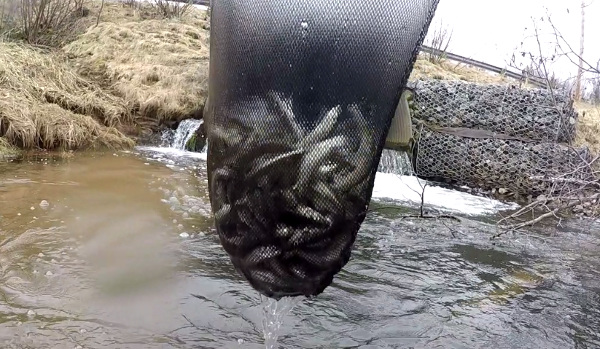
Every spring our rivers get overrun with rainbow smelt making their way up river to spawn. There is a dip net fishery for smelt that opens 15 days before the trout fishing season opens. It’s an excellent excuse to get out on the river and scout it out, all the while enjoying in the bounty of smelts.
This post uses amazon affiliate links. I receive commission from any sales at no additional cost to yourself.
How to catch smelts with a net?
Net fishing for smelts makes you feel like a kid again. In the video below I’m using waders to wade out into the middle of the river and chase these fish down. The waders make it much easier to chase the school of fish as they try to avoid your net.
You really don’t need waders to dip net fish for rainbow smelt though. There are plenty of places where the smelt will bunch up close to shore. River bends, culverts, and undercut riverbanks can all harbour large schools of smelt. All one has to do is sneak up on them by land and lunge to get a net full of fish. Even though waders are not a requirement, I would recommend at the very least wearing rubber boots.
Be mindful that the current in the rivers are often quite strong this time of year. Some years with excessive snow melt you may not be able to wade at all until the water levels die down a bit. That’s not usually an issue though, because in those years the smelt run is often delayed slightly due to the snow melt as well.
Fishing Net for Smelt (Amazon Link) can be bought here.
Chest Waders (Amazon Link) can be bought here.
How to catch smelts with a hook and line?
You can also fish smelt with a hook and line. Here on PEI you have to wait until trout season opens until you can put a hook in the water though, until that time you’re stuck using a net.
Smelt fishing lies firmly in the realm of micro fishing (targeting minnows, chubs, and other small species of fish), and the same techniques used in micro fishing will work well here. Micro fishing often uses wax worms, or other bait tipped on extremely small hooks, often under a bobber. Alternatively you can try micro jigs, Marabou jigs designed for panfish work very well for smelt. Use very light line and a lightweight rod to be able to cast these tiny lures more easily.
That being said, I’ve had the most fly fishing for smelt. These fish are very visually oriented predators, so movement tends to get their attention more than sitting bait does. Tie on a small streamer or nymph (sized 12 or smaller) and strip it back like you would any other streamer pattern.
I find small tinsel streamers, or other fly patterns with lots of flash to be the most effective when fly fishing for smelt. Small sized Mickey Finns or similar fly patterns also work well.
When do Smelt Run?
Smelt travel upstream in large schools to spawn in the spring, and usually start around early to mid April. They’ll travel pretty much as far up stream as they can before they start spawning. The rivers around here (PEI) are quite short though, so they may not travel as far upstream in areas with longer rivers. By the time mid May comes around, the smelt run is mostly over, so it’s a relativity short window.
The exact timing depends on the type of winter and spring we had that year. Heavier snowfall or a colder spring than usual may delay the smelt travelling up stream by a few weeks.
You also have an opportunity to scout the river while your out smelting. Take note of any changes to the river (downed trees, sunken river banks, new sand bars, etc) for when you’re out trout fishing later.
How to Prepare Smelt?
I clean smelt in much the same way I clean small trout.
- Make a slice behind the head, making sure to cut the spinal cord.
- Make an incision from the butt up the belly
- Remove the guts by pulling back on the head
- Wash out the body cavity with tap water
Done! This video does a good job of showing the cleaning process. Note that the two pectoral fins were removed with the head. This should be done on purpose, as they are attached to two sharp bones. It’s much easier to remove them now than later when you’re eating them. If they didn’t come out when you pulled the head and guts off, just cut them off with a pair of scissors.
Final Thoughts
As an added bonus, the smelt run offers ample opportunity to observe other wildlife. I saw a couple bald eagles, a mink, and untold numbers of sea gulls last time I was out. I even saw a pair of mallard ducks, one of which held a smelt in his mouth. I had no idea mallard ducks ate fish until that day. Even some songbirds (finches I think) were pecking at some dead smelt on the shore.
My experience with fishing smelts is on Prince Edward Island, but the same basic principles apply where ever smelt occur. I’ve recently moved to Ontario, and look forward to trying to track down some smelt runs in the Ottawa Valley area. I know they’re an invasive species in the Great Lakes, so I’ll be glad to do my part in lowering their population.

Great video Ben. I’m ignorant about smelts. Are they bait or food?
Thanks Howard,
I eat them, and they’re quite popular with locals here, alot of people actually ice fish for them.
They would work great as bait if regulations allowed. I know they’re a favourite forage fish of stripped bass, and larger brook and rainbow trout will eat them as well.